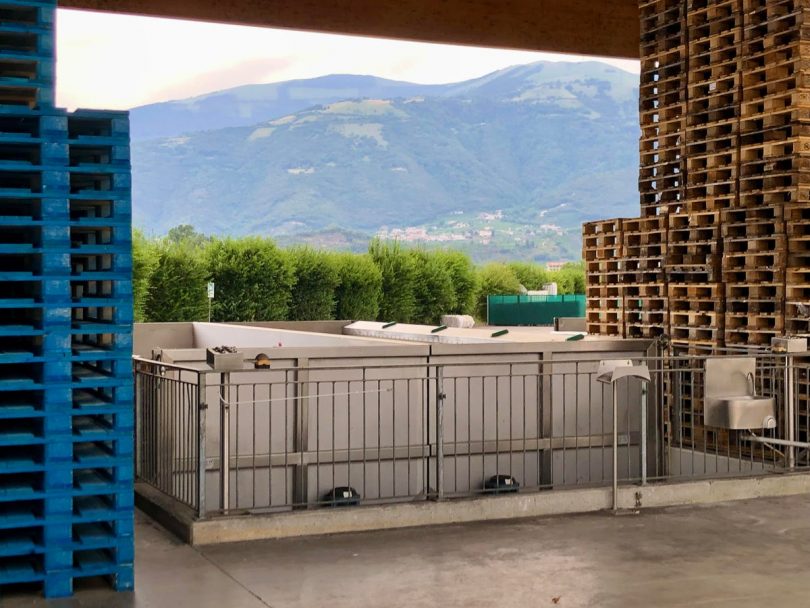Prosecco Superiore villages as seen from the Gruppo Cantina Produttori di Valdobbiadene’s Val d’Oca … [+]
Everyone talks about sustainability but no one remembers the names of the viticulturists, says Giovanni Pascarella of the recognition reserved instead for winemakers. He is the Advisor for Agronomic Activities for the Gruppo Cantina Produttori di Valdobbiadene, a cooperative on the western edge of the Veneto’s historic Prosecco hills with eighty percent of its members in the four steep comuni of Valdobbiadene, Vidor, Soligo, Miane, northwesternmost of Prosecco Superiore productions. There are 43 such steepnesses, called, officially since 2019, Rive. Together they are six percent of the Conegliano-Valdobbiadene DOCG’s vined territory, and, small plots owned separately and worked by hand, every year they take four times longer to care for than the 200 hours needed for each hectare in the region’s more mechanically inclined Prosecco-growing flatlands outside the denomination.
The Cantina was founded in 1952 by 129 growers responding to what the Second World War, “which caused profound devastations to souls and to society which needed to recover both economically and morally”1 had left in the hills. Pascarella is the son of a founder, a grower himself, and one of the cooperative’s now 591 members, who together know the area best over recent centuries. Such cooperative work might be one answer to a question like, “How could anyone define the collective agent that would rise up to solve climate change?” proposed by Martin Puchner, an editor of the Norton Anthology of World Literature. “Such an act,” Puchner writes, “would mean deciding how best to make that agent visible, what kind of manifesto or other genre would bring it to the forefront of our understanding.” A meeting place of UNESCO cultural preservation and ongoing responses to synthetic farming substances including the ban of glyphosate-based herbicides at the start of 2019, Prosecco Superiore is one such agent particularly readable in the work of 591 of its growers together. To recast wildly from “books” in Puchner’s writing, wines “are not neutral tools. Much like writing itself, they are complicit with the resource-extracting way of life that has accelerated in the last two hundred years. This complicity makes them valuable for understanding how we arrived at this critical moment in human history.” At the winery, members’ prized grapes are turned to sparkling wines, Prosecco Superiore bottles labelled Val d’Oca which since 2008 has been the cooperative’s azienda, born from their 1990s’-era restaurant-focused brand with a mission to present and safeguard where its members are. That is, harvested from 338 hectares of vines concentrated in the most difficult and storied parts of the DOCG’s more than 8,600 hectares (one-third, recently noted Diego Tomasi, viticultural researcher and new director of the DOCG’s Consorzio, of which are certified by the bee-logoed Integrated Crop Management National Quality System (SQNPI) — given age, difficulty in reaching, guidance with room for how it was done before, I will guess a higher number is true for the Rive).
Pascarella drives us up a gravelled runway departing slight via San Giacomo, from which he had been calling out the names of the small vineyard sites diving or soaring as we moved past them on this path promising to never end. “‘Names,’ writes the Native American botanist Robin Wall Kimmerer,” novelist Amitav Ghosh relays in his worried The Nutmeg’s Curse, “‘are the way we humans build relationships, not only with each other but with the living world.’” Of to practiced eyes recognizably different character from the rest, on hillside that falls from the road there’s the place called Bacio; Marche and Frati along instead some that rises up from it, within hundreds more place-names just from this road that has long led from Valdobbiadene to Guia. The words and Pascarella’s grasp on them are the long-daily passing down of knowledge, a continuation of stories that are part order, part ongoing attention to particulars, part of those who have walked these twisty falling places whose nature includes habit. “Thus far I have been singing of working the land, and stars in heaven,” reads a farmer-poet’s translation of Virgil’s Georgics, on turning place to agricultural place. So now I turn to you, Bacchus, you and the thick thickets people think of when they think of you, / and, while I’m at it, to what the slow-growing olive gives. It is an unexpectedly familiar image, a made scenario created long ago as is the task of writing, “byproduct of city life,”2 and tool of who like me has not been given such knowledges and habits. From where we stop for a few minutes, one can see best what both the cooperative and the greater Valdobbiadene zone mean, Pascarella says: a sweeping view from Valdobbiadene to Santo Stefano to Guia and behind them the 1,600-meter rise of mount Cesen to draw the clouds and in the summertime bring the ancient temperature drops in the evenings until morning. Here, rising to 450 meters above sea level, soils and rock of carbonato di calcio whose ways of moving and eroding are what is making these steep hills for rooting into, the only thing Pascarella’s ancestors could grow, he shares, were vines. In such a vista, a viticulturist sees “disorder, organized,” a landscape of walks to criss-cross forest paths, regularly chosen vines, the past two hundred years, irregular densely green-mottled marks that are older vineyards of mostly Glera, light-patchier-green spots that are more recent plantings including the old Prosecco varieties Perera (planted, massal, of cuttings from Prosecco’s prized Cartizze), Verdiso (from chestnut-rich Combai), and Bianchetta (from Colbertaldo to the east). Overall, the cooperative began its replanting project twenty years ago and from all four varieties they make their new bottling, “Uvaggio Storico,” a field blend as close to one way it was once done as the denomination’s disciplinare will allow, to “evoke suggestions of life 50 and more years ago,” and an elegant and comprehensive Prosecco built on acidity, promised bitterness, floral, instances of pear and chewy loquat. Training systems, straight lines, cultivars, industry, and lifestyle castings, here, uncommon difficulty, there are crooked rows as impossible as their hills. Among agriculture-made places, might viticulture — site of intoxication and no one really needs wine but there has long been Bacchus and there are (unnecessary for survival) millennia-old entanglements of vines and places and people — present listening solutions all its own. At last arrived, in this place where vines are among the very few things one can cultivate and where until recently, church bells rang the midday at 11:55 so that the contadini would know to start out for lunch, the riva, Pascarella says, is synonym of vigneto.
On maps instead and on land a little-larger scale and easier to find are those 43 Rive-names of sharp places pointedly hard to farm and beginning to appear more often on labels of Prosecco Superiore with more details about this already small denomination whose bottles are less than a sixth of all Prosecco. Twenty-nine of the cooperative’s founders were women: the majority of owners of rive-steep sites in the early to mid-20th century, notes Val d’Oca director Alessandro Vella, because such places, of use only to “cows, the stars, a few vines,” were passed on to daughters while valuably easy-to-plant and larger flatland sites were left to sons. The Cantina’s members raise vines in 183 Rive hectares — more than a third of all Rive territory since “always,” describes Vella — and 13 hectares of the prized Cartizze slopes hurtling across a little more than 100 hectares between Saccol and Santo Stefano, small groupings of houses and hills that are since the early twentieth century administratively frazioni of the Valdobbiadene comune. Like Santo Stefano (Val d’Oca’s bottling of this Riva is a bodied Extra-Brut, hay, ginger, spice, lemon), San Pietro di Barbozza (this time Brut, fragrant like candied-fruit, lemongrass, layered and elegant) is also a frazione of Valdobbiadene. Val d’Oca’s Cartizze is Dry, traditional typology of this small sun-drenched zone though a very few other producers are now making it as Extra-Brut; dense sweet lemon, sugar evident but also an elevating bitterish note as promised by correct Prosecco wines. Members also grow in the Rive of San Vito (in Valdobbiadene) and of Vidor (in an adjacent comune), which the cooperative will soon bring to market, too. Like agriculture, viticulture can be a problem but it can be also, land stewardship, be a solution of listening and longterm, as especially small growers (the Cantina’s most recent Sustainability Report shows its members hold an average 1.69 hectares each) know. “We are truly ‘inside’ the Superiore appellation,” Val d’Oca marketing manager Luca Maruffa wrote to me. “We are custodians of a large part of the Rive and their landscapes, so our role is to preserve all of that and improve our quality year by year.”
In these days of easy-going asphalt, quotidian and tenacious Pascarella makes another short drive up a grayed-white road (narrowly dug in crumbly earth and planted-countryside then eased by gravel, practice, and acceptance) to finally and precipitously point to the valley the cooperative’s brand is named for. Standing in this ridge we look over colloquial Oca. Throughout what we can see I know that numerous streams run, this long hot summer more furrows than water but anyway they follow hills’ turns into places where sand, stones, and cementing earth form messy yellow-white-brown rock into which vineyards root, “imaginatively restoring agency and voice to nonhumans.”3 From the scrabble top, dusty soils of bushes and airy drops, grapevines have learned slow and graceful clings, holding to a hill whose name I do not know but from where I can see small bounding recognizable rows reach the valley of the Vallone Molere stream, two-wheel-track pathways reaching back up from the longer road, and forest — the north face of the greater hills before us, the plains and then old wooded Montello. There is drought now in early July and in a month or so will come the time to fret about the harvest (but know that rain will arrive in time), “that always marvelous and worrying autumn,” write Giorgio Iori and Giancarlo Follador in the Cantina’s 50th anniversary tribute book. “There is a strange mechanism in this time … that of fear. This fear appears in the first half of September; at one time it appeared in mid-October, when havests stretched to the time of the Dead, to the first snowflakes.” Everything we have been talking about we are watching happen this year, Tomasi says, the growing season without rain and and restrictions for people using water, but many of these historic and learned vines still vivaciously stretching out tendrils while others, fewer, fluttered and neared a resting stage. All are equally under threat as well of another grapevine pest brought by mistake from the United States, this time late last century. This summer, in a carefully timed and targeted treatment against the American grapevine leafhopper which, free here from natural enemies, sows, smaller than a bacteria, the phytoplasma flavescenza dorata among sensitive Glera, flashes of rose-goldened and dying leaves and spurs sudden in the landscape matched by a desperate call for all growers to uproot the affected vines. “Without this sacrifice, made with a great sense of responsibility by most of our members, their commitment will be in vain, noted a worried call to action from the consorzio. “In a few days the insect will become infectious and if it finds sick vines, what has been done so far will have been useless.” After a three-day treatment, on July 7, 95% of the insects were gone, Tomasi told me the day after. Together, the growers did it, this time.
Since the later 19th century, the Venetian countryside has been, with the encouragement and direct involvement of the Catholic Church, a place of cooperation and a culture of associazionismo. Newly a nation, Italy’s casse rurali were mutual lending institutions for small growers (owners, renters, sharecroppers, note Massimo Fornasari and Vera Zamagni in their late-1990s research on cooperative movements in Italy) within a parish, and concentrated in the old Venetian republic which 69 years after its fall would begin becoming northeast Italy. In 1897, “the casse rurali were in great part located in the Veneto, a region still prevalently, rural,”4 and part of Italy for 31 years. Building from the start of 1892, in first days of the new century there were 779 officially Catholic casse. Already later that first year, from zero, 30 Catholic ones were added to 74 liberal ones. Touted as economic move, cooperative is at the same time expression and defense of a culture and life of place become specific. So, the other places Prosecco Superiore can be made are the towns in the Asolo DOCG, on the war-devastated western bank of the Piave river but where “by the middle of July, 1918, the Italians had cleared [it] of enemy troops.” The cooperative holds an experimental vineyard there (and also farm 85 of the denomination’s 2,708 hectares from which, depending on vintage, about 2,600 hectoliters of Superiore to add to 56,000 hectoliters of the larger denomination), working out various treatment approaches entangled with simulated scenarios that forecast the weathers we’re heading into, with plant-defense-stimulating “elicitors” that might make it easier to use less copper in more humid sites’ organic vineyards (less than 4 kg/ha allowed in application annually, “difficult, but possible sometimes, like this year!” notes Maruffa of 2022), testing new products against the leafhopper and plant-defense-activators against the tiny yellowing organism it trails through vineyards. Across the cooperative’s wide production (they produce DOC wines, too), vessels are accordingly scaled: for alchoholic fermentation 250 tanks in 30 to 2,400 hectoliters; 65 of the autoclaves the Italian sparkling wine method demands, in 300 and 600 hectoliters. When the time comes, 65,000 bottles of which 25,000 are Val d’Oca will be filled per day. These measurements are one vista of a massive collective action’s particulars, handworked and -gathered delicately fragrant Glera and guarded cultivars from before the Prosecco boom. The Cantina is reducing packaging materials and recycling glass bottles, plastics, tartrates, stems, and vinacce, all of which are consigned to partnering aziende for true reuse and recycling. Energy, water, air: the plan is to be completely autonomous, including water, by 2030.
“Generally speaking,” Maruffa says, “our vinegrowers own vineyards in nine Rive (Guia, San Martino, Vidor, San Giovanni, San Vito, Combai, San Pietro, Santo Stefano and Colbertaldo),” — names that mark particularities in topography and related weather and within which longer patterns of climate, cultures, habits changing can be sought. “The anthropologist Keith H. Basso,” writes Ghosh, “writes about an elder of the Western Apache, Charles Hènry, for whom the clues to the changes in his environment lay in place-names … These places are all tied to stories that describe how they got their names … The discrepancies between the names, the stories, and the realities of the present day … show what is different and what is still the same.’” After having opened more than one bottle of “Uvaggio Storico” this year, I realize the label is to be peeled back, and do so. “We thought that knowing aromas and tastes of the past isn’t just simple academics,” read two new surfaces, “but represents the conscious rediscovery of that which our predecessors had passionately appreciated, tended, and passed down for generations. Until the late 1960s the varietal composition of vineyards in the Valdobbiadene area was in part different from today’s.” Members’ grapes from the San Pietro di Barbozza, Santo Stefano and Colbertaldo will be added to Val d’Oca’s lineup, and the cooperative is thinking now about harvest next year, Maruffa says, “to propose something interesting and new in 2024.” Saline, Molere, Parè, Pascarella calls out as we drive, Prosecco, Verdiso, Perrera, Bianchetta Trevigiana Val d’Oca’s wines respond to who takes the time to listen. The full story of “Uvaggio Storico” doesn’t show up right away: open it the day before, pour a small amount so you will be able to know the changes, then store it under refrigeration and spumante top until tomorrow.








